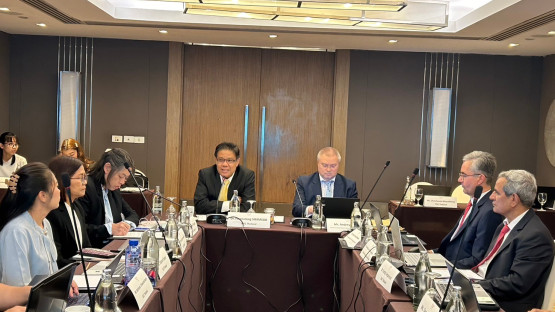An international team of experts led by the IAEA has concluded a second Integrated Nuclear Infrastructure Review for Research Reactors (INIR-RR) mission in Thailand. Performed at the request of the Thai government, the follow-up mission assessed Thailand’s preparedness to move forward with plans for two new research reactors.
The mission, conducted from 29 April to 3 May, reviewed work done by the Thailand Institute of Nuclear Technology (TINT), the Suranaree University of Technology (SUT) and the Office of Atoms for Peace (OAP) since the initial INIR-RR mission was carried out in late 2021. Activities included a series of roundtable discussions on various technical topics relevant to the establishment of a new research reactor programme as well as a review of documents detailing the implementation of recommendations made during the main mission in 2021. The team noted progress in several key areas, including the regulatory framework, human resource development and procurement standards.
“Our team observed that OAP, TINT and SUT have been highly proactive in addressing the recommendations from 2021, and we greatly appreciate their openness and transparency,” said Andrey Sitnikov, the IAEA Technical Lead for Research Reactor Infrastructure Development who led the mission team. “They have, for example, taken advantage of an IAEA modelling tool to help assess their human resource needs and continue to strengthen their regulatory framework for nuclear installations.” The team also noted significant participation from many well qualified women during the technical discussions, he added.
Thailand has more than four decades of experience in research reactor operation, with its TRR-1/M1 reactor coming online in 1977. The TRIGA Mark III reactor is put to work on many applications including the production of beneficial isotopes such as samarium-153, which is used in nuclear medicine, and functions as a neutron imaging facility in addition to serving as a key training centre.
The Southeast Asian country is preparing to build on this experience and aims to construct two new research reactors, one at SUT and the other at TINT. The planned SUT facility is based on miniature neutron source reactor (MNSR) technology and will be used for neutron capture therapy, a cancer treatment technique, among other applications. TINT’s new facility, to be built at the Ongkharak Nuclear Research Centre (ONRC), is envisioned as another multipurpose research reactor that will eventually replace the TRR-1/M1.
“This mission has helped SUT understand and develop better processes for setting up the research reactor facility,” said Chinorat Kobdaj, Head of SUT’s Boron Neutron Capture Therapy Centre. “Offering feedback in the form of suggestions and recommendations allows us to improve the quality, safety and security of our facility.”
The Milestones Approach, a phased comprehensive method supporting the development of nuclear infrastructure, was originally conceived of to support the implementation of new nuclear power programmes. It has since been adapted to address requirements specific to research reactor programmes.
“The INIR-RR mission made us aware of the gaps in our regulatory functions,” said Pantip Ampornrat, a Senior Nuclear Engineer at OAP. “We see how we can improve our organization to be even better.”
About the INIR-RR peer review service
The INIR-RR review mission is designed to assist a Member State in determining the status of its national nuclear infrastructure and to identify further development needs to support new research reactor projects. The IAEA has developed INIR-RR to respond to Member States’ requests to assess the status of and identify improvements of their national nuclear infrastructure. An INIR-RR mission is a holistic, IAEA-coordinated peer review, conducted by a team of international experts who have direct experience in specialized research reactor infrastructure areas.





